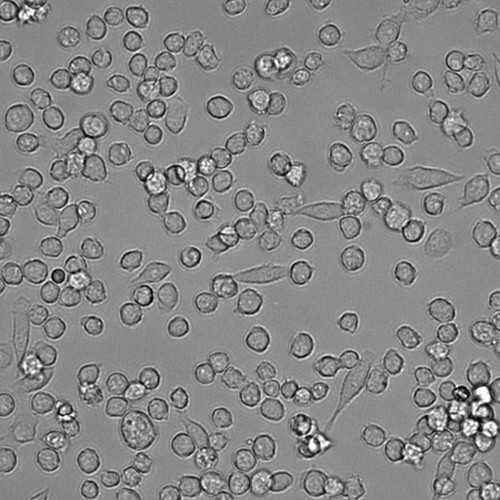Microglial Cell Line (SIM-A9)
Microglial cell line (SIM-A9) expresses macrophage/microglia specific proteins, CD68 and Iba1.
Highlights:
- Cells express macrophage/microglia-specific proteins, CD68 and Iba1
- Responsive to exogenous inflammatory stimulation with lipopolysaccharide and ß-amyloid, triggering tyrosine kinase-mediated NFkB signaling cascades and TNFa secretion
- Exhibit phagocytic uptake of fluorescent labeled ß-amyloid and bacterial bioparticles
- Cells can be induced to pro- or anti-inflammatory M1/M2 microglial phenotypes
- Model system for microglial behavior in vitro
Microglia cells share functional similarities with macrophages, and are thought to act as the primary immune cells of the central nervous system (CNS). They monitor their microenviornment and become activated upon detection of abnormal and/or offensive signals. Activated microglia have been found in inflammatory conditions such as brain/spinal cord injury, ischemic strokes, infections and neurodegenerative diseases. Recent findings indicate that microglia are also involved in learning and memory by regulating synaptic plasticity.
From the laboratory of Kumi Nagamoto-Combs, PhD, University of North Dakota.
Microglial cell line (SIM-A9) expresses macrophage/microglia specific proteins, CD68 and Iba1.
Highlights:
- Cells express macrophage/microglia-specific proteins, CD68 and Iba1
- Responsive to exogenous inflammatory stimulation with lipopolysaccharide and ß-amyloid, triggering tyrosine kinase-mediated NFkB signaling cascades and TNFa secretion
- Exhibit phagocytic uptake of fluorescent labeled ß-amyloid and bacterial bioparticles
- Cells can be induced to pro- or anti-inflammatory M1/M2 microglial phenotypes
- Model system for microglial behavior in vitro
Microglia cells share functional similarities with macrophages, and are thought to act as the primary immune cells of the central nervous system (CNS). They monitor their microenviornment and become activated upon detection of abnormal and/or offensive signals. Activated microglia have been found in inflammatory conditions such as brain/spinal cord injury, ischemic strokes, infections and neurodegenerative diseases. Recent findings indicate that microglia are also involved in learning and memory by regulating synaptic plasticity.
From the laboratory of Kumi Nagamoto-Combs, PhD, University of North Dakota.
| Product Type: | Cell Line |
| Name: | SIM-A9 |
| Cell Type: | Spontaneously immortalized microglia cell line |
| Accession ID: | CVCL_5I31 |
| Morphology: | Heterogenous; spindle, multi-polar, spherical, flat |
| Organism: | Mouse C57BL/6 |
| Source: | Postnatal day 1-2 mouse cerebral cortex |
| Biosafety Level: | BSL1 |
| Growth Conditions: | DMEM/F12 with 5% DHS, 10% FBS, Pen-strep, neomycin (optional) |
| Cryopreservation: | 10% DMSO in DMEM/F12 growth medium above |
| Storage: | Liquid nitrogen |
| Shipped: | Dry ice |
Photomicrographs of SIM-A9 Cells

SIM-A9 cells expressing microglia/macrophage-specific proteins. SIM-A9 cells were treated without (Control; left panels) or with 2.5 ng/mL LPS(LPS; right panels) for 24 h prior to immunostaining for microglial markers, CD68 or Iba1, as well as for astrocyte and neuronal marker proteins, GFAP and MAP2, respectively. Scale bar = 50um.
Adapted from: Kumi Nagamoto-Combs., et al. J Neurosci Methods. 2014 Aug 15;233:187-98.
- Kumi Nagamoto-Combs, Joshua Kulas, Colin K. Combs. A novel cell line from spontaneously immortalized murine microglia. J Neurosci Methods. 2014 Aug 15;233:187-98.
- Farrell K, Borazjani A, Damaser M, Kothapalli CR. Differential regulation of NSC phenotype and genotype by chronically activated microglia within cocultures. Integr Biol (Camb). 2016 Nov 7;8(11):1145-1157. View Article
- Xing F, Liu Y, Wu SY, Wu K, Sharma S, Mo YY, Feng J, Sanders S, Jin G, Singh R, Vidi PA, Tyagi A, Chan MD, Ruiz J, Debinski W, Pasche BC, Lo HW, Metheny-Barlow LJ, D'Agostino RB Jr, Watabe K. Loss of XIST in Breast Cancer Activates MSN-c-Met and Reprograms Microglia via Exosomal miRNA to Promote Brain Metastasis. Cancer Res. 2018 Jul 19. View Article
- Dave KM, Ali L, Manickam DS. Characterization of the SIM-A9 cell line as a model of activated microglia in the context of neuropathic pain. PLoS One. 2020;15(4):e0231597. Published 2020 Apr 14. View Article
- You MJ, Bang M, Park HS, et al. Human umbilical cord-derived mesenchymal stem cells alleviate schizophrenia-relevant behaviors in amphetamine-sensitized mice by inhibiting neuroinflammation. Transl Psychiatry. 2020;10(1):123. Published 2020 Apr 27. View Article
- Wu SY, Xing F, Sharma S, et al. Nicotine promotes brain metastasis by polarizing microglia and suppressing innate immune function. J Exp Med. 2020;217(8):e20191131. View Article
If you publish research with this product, please let us know so we can cite your paper.


